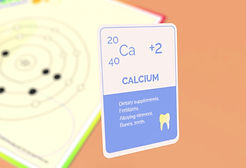Info Design • Gamification • Identity Design
CHEMPLAY
10 Weeks • 2021
TEAM OVERVIEW
2 Product Designers
1 Subject Matter Expert
1 Business Analyst
MY ROLE
Market Analysis • User Research • Insight extraction • Concept Strategy • Visual Identity & Branding
RESEARCH METHODS
Focus Group Interviews • In-depth User Interviews • Gameplay Observation & Testing • Literature study • Competitor Analysis • Business Model Canvas
Sincere thanks to Mr Zubin Savla and Ms Sanjana Nanodkar for giving me the opportunity to work on TCTD Chemplay. Big thanks to Dr Nitin Bhate, Mrs. Pradnya Gokhale and Mrs. Shalini Kumar, who conceptualized the game, for giving me the liberty to enhance the product,.
THE CHALLENGE
How might we redesign a Chemistry kit to enhance engagement and playful learning while strategically reducing costs to maximize accessibility for students across India?
THE OUTCOME
Chemplay: A streamlined board and card game with a unique brand identity, optimized materials, and production cuts that reduced costs by 73% from the initial prototype.

Cooperative + playful learning journey with minimal supervision




Transforms the fear of the unknown (the subject) into fascination by encouraging independent thinking

THE PROCESS
Game based Learning
In-game learning is enhanced by making thinking visible and applying knowledge in meaningful ways, also boosting motivation.

Games are a powerful source of instruction

A crucial factor in knowledge retention

Aid in understanding new concepts
Analyzing the Product
Chemplay consists of six games, each focused on a fundamental chemistry concept.
To better understand the product, the team and I played multiple rounds of each game, identifying pain points, unique differentiators, and key factual insights. These include:
-
Varied entities in different sizes, colors, and materials increases the risk of misplacement.
-
The inconsistent design language makes it difficult for players to distinguish between the game and its components.
-
Confusing language on instruction cards creates uncertainty and hinders user understanding.
3 Field Experiments



Playdates
Focus Group Discussion
In-depth User Interviews (in person and via telephone)
with
Users: Early Teenagers [12 to 14 year olds]
Customers: Parents, Teachers, School staff
Key Insights: Users
-
Short attention span but high concentration level
-
Interests shaped by peer influence
-
This age group thrives in cooperative settings and maintains a positive attitude towards learning
-
The concepts in Chemplay are a bit challenging to grasp
Key Insights: Customers
-
Indian parents prefer educational games or DIY kits focused on academic subjects
-
Often choose products that can grow with their child
-
Urban parents typically spend under Rs. 600 per game
-
In rural areas, academic learning is primarily limited to school, with little exposure to coaching or home tuition
-
Customers in rural settings are teachers or panchayats with limited budgets for educational products
-
Partnerships with NGOs, startups, and CSR initiatives could help bridge the affordability gap
The Strategy
Help users find meaning and engage by adding a narrative that connects learning chemistry to a higher purpose
Provide a sense of control to the user, build a competitive yet non-threatening environment
Transform the fear of the unknown (the subject) into fascination by encouraging independent thinking and the benefits of trial and error
Ensure the product is self-sufficient, requiring minimal external supervision
Visual Identity
There was a dire need to create a unified design language for the entities, ensuring a cohesive identity that resonates with the games-
-
The logo symbol/type must be bold and engaging
-
Grab the attention of Gen Z, who have a short attention span
-
The color scheme should inspire trust among parents, conveying the product's usefulness and promise
-
Also maintaining a fun, playful vibe that appeals to kids



Instruction Cards
Each game has its own instruction card, aligned with the brand's visual identity. The focus was on highlighting the game number, instructions, and learning outcomes, with steps illustrated for added visual appeal.
Final Redesign
Considering storage and weight, the team decided to use 'kappa board' for mass production of the packaging. The box lid, when flipped, reveals space to tuck the instruction cards, making them stand out and grab attention upon opening.












Revised Cost
The cost structure of each entity varied based on production quantity. With a few components replaced or eliminated, the overall product cost was significantly reduced.
Before redesigning, 20 prototypes of Chemplay were made, each costing around Rs. 2000. The final product is estimated to cost Rs. 538.

₹73
₹90
₹80
₹25
₹30
₹30
₹210
₹538
Key Learnings
A designer should not only create but also communicate and present concepts clearly to non-designers, avoiding jargon.
It's important to plan thoroughly, set milestones, and work towards achieving the goal.
While the outcome in this case was clear, which motivated us, not all projects have such clarity. Therefore, it's crucial to understand the potential impact of a project and make design decisions accordingly.
The Team
.png)
"We were delighted to have Rahi on our team because of her friendly and enthusiastic nature. During her time at the firm, I observed her progress from a shy individual to a confident and fearless one. She definitely has an eye for detail.
She holds conversations very well. Our topics of discussion ranged from psychology, spirituality, sports, food, culture, etc. Moreover, she is a keen listener, and one thing I noticed was that she implemented various lessons from our discussions in her daily life. Passionately exploring life, she recognizes how there's SO MUCH to learn from it!"
Sanjana Nanodkar
Manager, Tata Centre for Technology and Design, IIT Bombay










